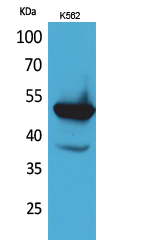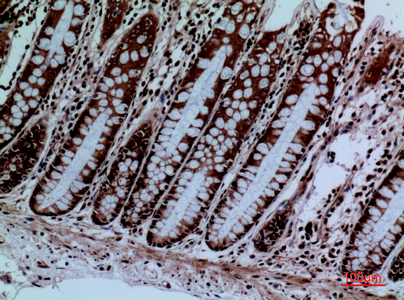产品名称
Protein C Rabbit Polyclonal Antibody
别名
PROC; Vitamin K-dependent protein C; Anticoagulant protein C; Autoprothrombin IIA; Blood coagulation factor XIV
蛋白名称
Vitamin K-dependent protein C
存储缓冲液
Liquid in PBS containing 50% glycerol, 0.5% BSA and 0.02% New type preservative N.
Human Gene Link
http://www.ncbi.nlm.nih.gov/sites/entrez?db=gene&term=5624
Human Swissprot No.
P04070
Human Swissprot Link
http://www.uniprot.org/uniprotkb/P04070/entry
Mouse Swissprot No.
P33587
Mouse Swissprot Link
http://www.uniprot.org/uniprot/P33587
免疫原
The antiserum was produced against synthesized peptide derived from the Internal region of human PROC. AA range:181-230
特异性
Protein C Polyclonal Antibody detects endogenous levels of Protein C protein.
稀释度
WB 1:500 - 1:2000. IHC-p: 1:100-300 ELISA: 1:20000.. IF 1:50-200
宿主
Polyclonal, Rabbit,IgG
背景介绍
This gene encodes a vitamin K-dependent plasma glycoprotein. The encoded protein is cleaved to its activated form by the thrombin-thrombomodulin complex. This activated form contains a serine protease domain and functions in degradation of the activated forms of coagulation factors V and VIII. Mutations in this gene have been associated with thrombophilia due to protein C deficiency, neonatal purpura fulminans, and recurrent venous thrombosis.[provided by RefSeq, Dec 2009],
组织表达
Plasma; synthesized in the liver.
细胞定位
Secreted . Golgi apparatus . Endoplasmic reticulum .
信号通路
Complement and coagulation cascades;
功能
catalytic activity:Degradation of blood coagulation factors Va and VIIIa.,disease:Defects in PROC are the cause of protein C deficiency autosomal dominant (ADPROCD) [MIM:176860]. ADPROCD is a cause of hereditary thrombophilia, a hemostatic disorder characterized by impaired regulation of blood coagulation and a tendency to recurrent venous thrombosis. However, many adults with heterozygous disease may be asymptomatic. Individuals with decreased amounts of protein C are classically referred to as having type I protein C deficiency and those with normal amounts of a functionally defective protein as having type II deficiency.,disease:Defects in PROC are the cause of protein C deficiency autosomal recessive (ARPROCD) [MIM:612304]. ARPROCD results in a thrombotic condition that can manifest as a severe neonatal disorder or as a milder disorder with late-onset thrombophilia. The severe form leads to neonatal death through massive neonatal venous thrombosis. Often associated with ecchymotic skin lesions which can turn necrotic called purpura fulminans, this disorder is very rare.,function:Protein C is a vitamin K-dependent serine protease that regulates blood coagulation by inactivating factors Va and VIIIa in the presence of calcium ions and phospholipids.,miscellaneous:Calcium also binds, with stronger affinity to another site, beyond the GLA domain. This GLA-independent binding site is necessary for the recognition of the thrombin-thrombomodulin complex.,online information:Protein C entry,PTM:Partial (70%) N-glycosylation of Asn-371 with an atypical N-X-C site produces a higher molecular weight form referred to as alpha. The lower molecular weight form, not glycosylated at Asn-371, is beta.,PTM:The iron and 2-oxoglutarate dependent 3-hydroxylation of aspartate and asparagine is (R) stereospecific within EGF domains.,PTM:The vitamin K-dependent, enzymatic carboxylation of some Glu residues allows the modified protein to bind calcium.,sequence caution:Translated as Cys.,similarity:Belongs to the peptidase S1 family.,similarity:Contains 1 Gla (gamma-carboxy-glutamate) domain.,similarity:Contains 1 peptidase S1 domain.,similarity:Contains 2 EGF-like domains.,subunit:Synthesized as a single chain precursor, which is cleaved into a light chain and a heavy chain held together by a disulfide bond. The enzyme is then activated by thrombin, which cleaves a tetradecapeptide from the amino end of the heavy chain; this reaction, which occurs at the surface of endothelial cells, is strongly promoted by thrombomodulin.,tissue specificity:Plasma; synthesized in the liver.,
纯化
The antibody was affinity-purified from rabbit antiserum by affinity-chromatography using epitope-specific immunogen.


.jpg)

